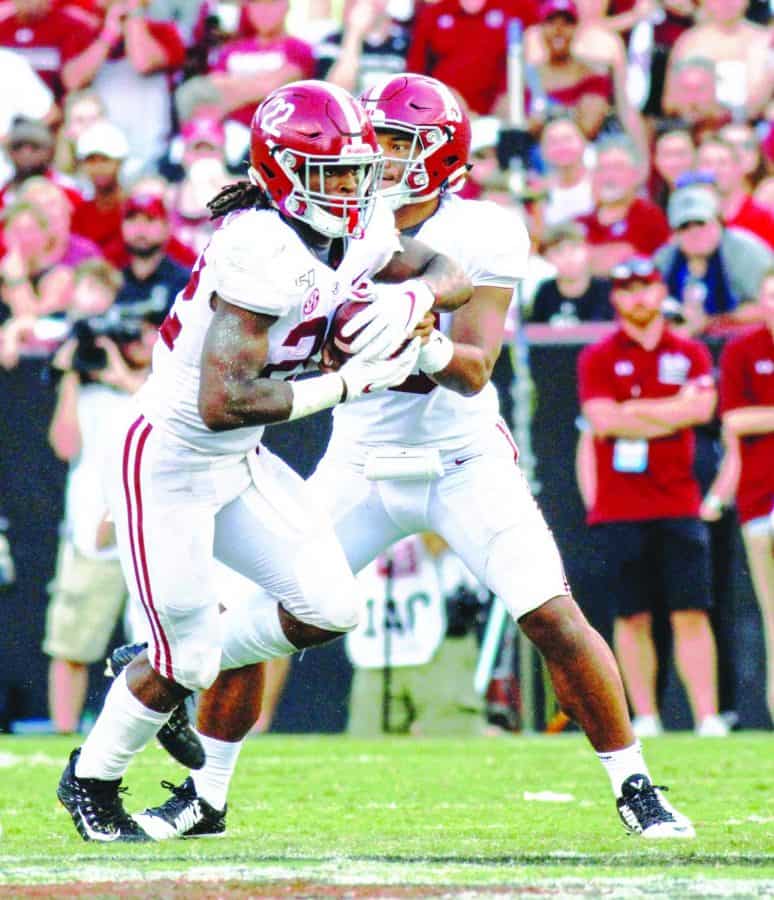Run-pass option remains lethal for Alabama offense
September 21, 2019
Historically, the Alabama football team has been known for its ground-and-pound style of offensive production. In 2009 – the year that the Crimson Tide won its 13th national championship – Alabama averaged 215.1 rushing yards per game while averaging just 187.9 passing yards.
Times change, however, and the game of football has evolved. For Alabama, gone are the years of the heavy rushing attack, with the majority of offensive yards coming from the air and the utilization of the run-pass option, or RPO.
The use of the RPO for Alabama has brought the team success so far in the 2019 season. Through three games, the Crimson Tide has 1,147 yards in the air and 539 yards on the ground in 99 rushing attempts. Junior quarterback Tua Tagovailoa, along with offensive coordinator Steve Sarkisian, has drastically shifted the means of production for the Alabama offense with his dual-threat style of play.
Junior wide receiver DeVonta Smith said that the RPO is now the identity of the team’s offense.
“[The identity is] being able to run and pass, doing both at a very efficient level,” Smith said.
An RPO is an offensive scheme in which the team’s offensive line run blocks for the entirety of the play, and the quarterback makes a decision either pre- or post-snap to hand off or throw. While the Crimson Tide is a predominantly zone-running team, the RPO allows the quarterback to read the defense and make a snap decision on what he believes best works against the defensive scheme, keeping defenses on their toes and allowing versatility for the offense.
In its game against South Carolina, Alabama utilized this strategy successfully. Against a solid Gamecocks defense, the Crimson Tide racked up 571 total yards, with 495 of those yards through the air. Alabama averaged 12.7 yards per pass, demonstrating that the RPO kept the opposing defense off-guard throughout the game.
“There was a lot of one-high [safety], so when you play a lot of one-high, it’s mostly playing man [coverage] and you’re trying to bring a safety down on the tight end,” Smith said. “And that’s basically who you read most of the time, the safety. So just with them being one-high, there’s always a safety down, and that just opened it up for the passing game.”
While the Crimson Tide had success in the air on Saturday, a quick look at the rushing stats shows the team only gained 76 rushing yards on 25 attempts, averaging three yards per rush. However, this is understandable in an RPO system. If a quarterback predominantly chooses to throw the ball, it inflates the passing stats while deflating the rushing stats.
Smith understands that the low rushing numbers don’t necessarily correlate with a poor rushing performance.
“I feel like a lot of people say we can’t run the ball, but what they fail to realize is, there’s a lot of RPOs,” Smith said. “So you can’t necessarily say we can’t run the ball, because he’s supposed to be throwing it. And I feel like that’s putting a chip on the running backs’ and linemen’s shoulders, and I just thank everybody for that. As you [have] seen this weekend, our running backs can do it all. So people [are] going to talk and say what they want to say, but all they [are] doing is getting our linemen and running backs fired up.”
Many fans are not used to seeing such low rushing numbers, and while the low rushing performance for the Crimson Tide is understandable due to the RPO-style offense, an improvement in the running game will definitely be needed once Alabama starts playing its difficult SEC schedule later this season.
After the South Carolina game, Alabama head coach Nick Saban addressed the low rushing numbers and their correlation to the RPO.
“I know we got lots of yards, but we only got 76 yards rushing, so we gotta be able to run the ball better,” Saban said. “Not that we run it poorly, we just didn’t run it enough. And a lot of the plays that we ran today are called runs or RPOs, and we end up passing because they’re playing six guys in the box. It’s not the play call as much as it is the design of what we’re doing.”
Last year with Tagovailoa starting at quarterback for the first time, the Alabama offense increased from 193.4 yards per game passing in 2017 to 323.6 yards per game. On the running side, the number decreased from 250.6 rushing yards per game in 2017 to 198.4 yards per game. This perfectly demonstrates the effects an RPO-style of offense has on the running game.
Regardless of the low rushing numbers, it is fair to say that Alabama is in a new era of offense in Tuscaloosa. Gone are the days of the ground-and-pound. Welcome to the era of the RPO.










